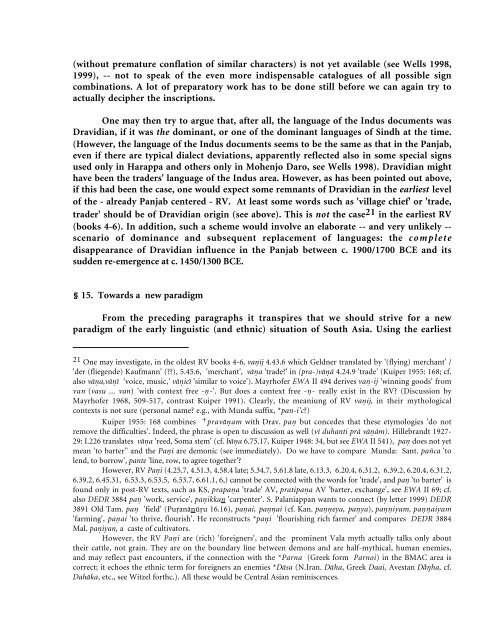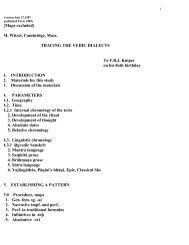The Languages of Harappa - People Fas Harvard
The Languages of Harappa - People Fas Harvard
The Languages of Harappa - People Fas Harvard
You also want an ePaper? Increase the reach of your titles
YUMPU automatically turns print PDFs into web optimized ePapers that Google loves.
(without premature conflation <strong>of</strong> similar characters) is not yet available (see Wells 1998,<br />
1999), -- not to speak <strong>of</strong> the even more indispensable catalogues <strong>of</strong> all possible sign<br />
combinations. A lot <strong>of</strong> preparatory work has to be done still before we can again try to<br />
actually decipher the inscriptions.<br />
One may then try to argue that, after all, the language <strong>of</strong> the Indus documents was<br />
Dravidian, if it was the dominant, or one <strong>of</strong> the dominant languages <strong>of</strong> Sindh at the time.<br />
(However, the language <strong>of</strong> the Indus documents seems to be the same as that in the Panjab,<br />
even if there are typical dialect deviations, apparently reflected also in some special signs<br />
used only in <strong>Harappa</strong> and others only in Mohenjo Daro, see Wells 1998). Dravidian might<br />
have been the traders' language <strong>of</strong> the Indus area. However, as has been pointed out above,<br />
if this had been the case, one would expect some remnants <strong>of</strong> Dravidian in the earliest level<br />
<strong>of</strong> the - already Panjab centered - RV. At least some words such as 'village chief' or 'trade,<br />
trader' should be <strong>of</strong> Dravidian origin (see above). This is not the case 21 in the earliest RV<br />
(books 4-6). In addition, such a scheme would involve an elaborate -- and very unlikely -scenario<br />
<strong>of</strong> dominance and subsequent replacement <strong>of</strong> languages: the complete<br />
disappearance <strong>of</strong> Dravidian influence in the Panjab between c. 1900/1700 BCE and its<br />
sudden re-emergence at c. 1450/1300 BCE.<br />
§ 15. Towards a new paradigm<br />
From the preceding paragraphs it transpires that we should strive for a new<br />
paradigm <strong>of</strong> the early linguistic (and ethnic) situation <strong>of</strong> South Asia. Using the earliest<br />
21 One may investigate, in the oldest RV books 4-6, vaij 4.43.6 which Geldner translated by '(flying) merchant' /<br />
'der (fliegende) Kaufmann' (??), 5.45.6, 'merchant', våa 'trade?' in (pra-)våá 4.24.9 'trade' (Kuiper 1955: 168; cf.<br />
also våa,våī 'voice, music,' våicī 'similar to voice'). Mayrh<strong>of</strong>er EWA II 494 derives va-ij 'winning goods' from<br />
van (vasu ... van) 'with context free --'. But does a context free -- really exist in the RV? (Discussion by<br />
Mayrh<strong>of</strong>er 1968, 509-517, contrast Kuiper 1991). Clearly, the meaniung <strong>of</strong> RV vaij, in their mythological<br />
contexts is not sure (personal name? e.g., with Munda suffix, *pan-i'c?)<br />
Kuiper 1955: 168 combines + pravåam with Drav. pa but concedes that these etymologies 'do not<br />
remove the difficulties'. Indeed, the phrase is open to discussion as well (ví duhanti prá våám). Hillebrandt 1927-<br />
29: I.226 translates våa 'reed, Soma stem' (cf. båa 6.75.17, Kuiper 1948: 34, but see EWA II 541), pa does not yet<br />
mean 'to barter'' and the Pai are demonic (see immediately). Do we have to compare Munda: Sant. pañca 'to<br />
lend, to borrow', pante 'line, row, to agree together'?<br />
However, RV Pai (4.25.7, 4.51.3, 4.58.4 late; 5.34.7, 5.61.8 late, 6.13.3, 6.20.4, 6.31.2, 6.39.2, 6.20.4, 6.31.2,<br />
6.39.2, 6.45.31, 6.53.3, 6.53.5, 6.53.7, 6.61.1, 6,) cannot be connected with the words for 'trade', and pa 'to barter' is<br />
found only in post-RV texts, such as KS, prapaa 'trade' AV, pratipaa AV 'barter, exchange', see EWA II 69; cf.<br />
also DEDR 3884 pa 'work, service', paikkan 'carpenter'. S. Palaniappan wants to connect (by letter 1999) DEDR<br />
3891 Old Tam. pa 'field' (Puanånūu 16.16), paai, paai (cf. Kan. paeya, paya), paiyam, paaiyam<br />
'farming', paai 'to thrive, flourish'. He reconstructs *pai 'flourishing rich farmer' and compares DEDR 3884<br />
Mal. paiyan, a caste <strong>of</strong> cultivators.<br />
However, the RV Pai are (rich) 'foreigners', and the prominent Vala myth actually talks only about<br />
their cattle, not grain. <strong>The</strong>y are on the boundary line between demons and are half-mythical, human enemies,<br />
and may reflect past encounters, if the connection with the *Parna (Greek form Parnoi) in the BMAC area is<br />
correct; it echoes the ethnic term for foreigners an enemies *Dåsa (N.Iran. Dåha, Greek Daai, Avestan Dha, cf.<br />
Dahåka, etc., see Witzel forthc.). All these would be Central Asian reminiscences.

















